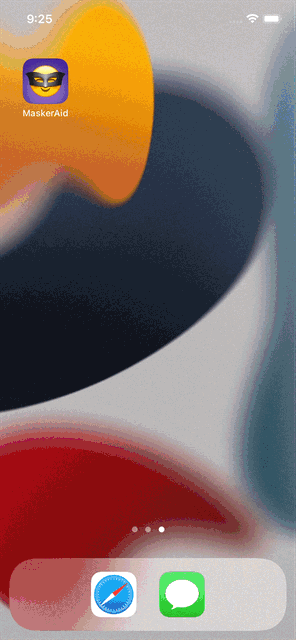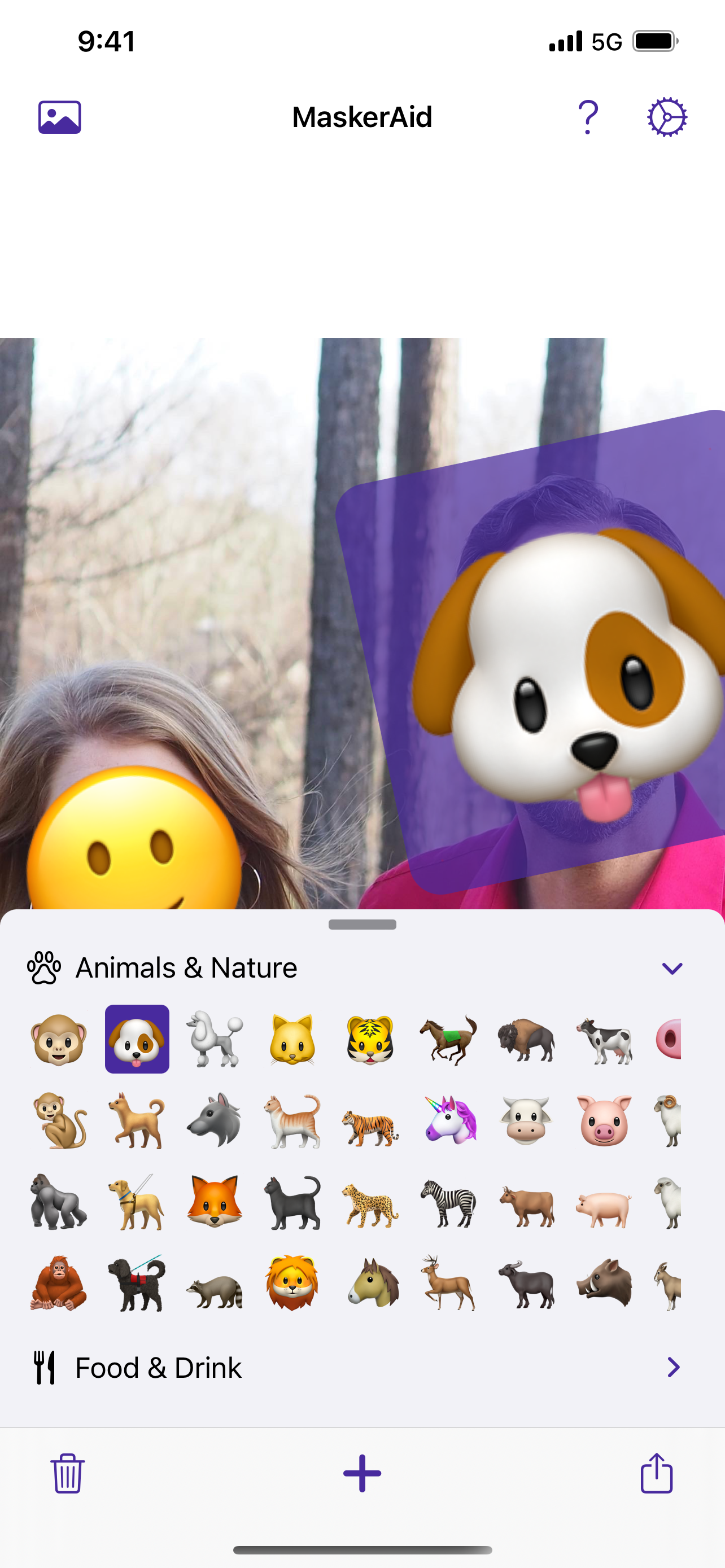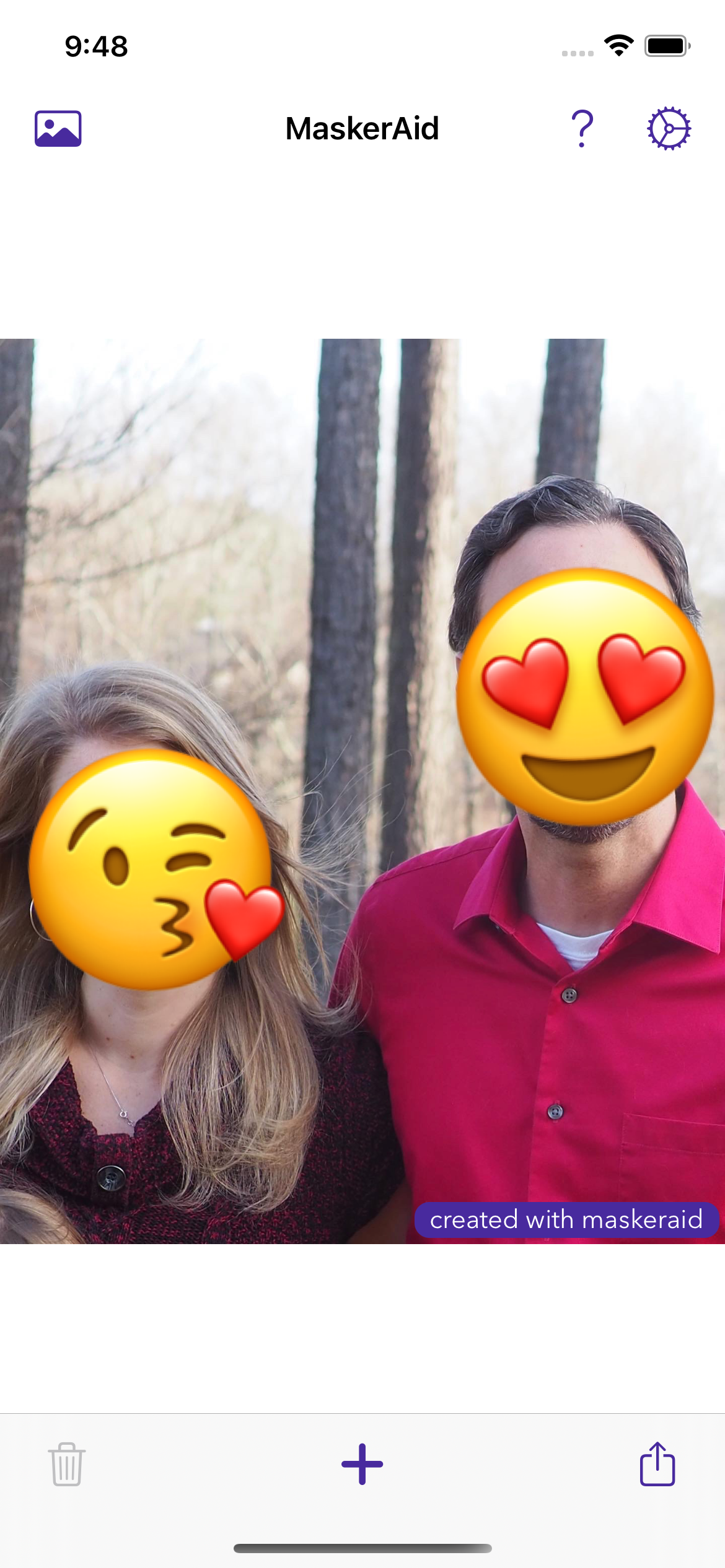Today, I’m overjoyed to announce my latest app, MaskerAid!

In short, MaskerAid allows you to quickly and easily add emoji to images. Plus, thanks to the magic of ✨ machine learning ✨, MaskerAid will automatically place emoji over any faces it detects. There’s several reasons you may want to hide a face:
- The face of a child who is too young to consent to their image being shared
- The faces of the children in your classroom, or your own classmates, who really don’t need to be in your images
- The faces of protestors who are standing up against a grotesque war
- The other faces in a particularly great shot of you, but was taken as part of a group
There are other reasons you may want to simply add an emoji to an image, but not on top of a face:
- Perhaps you want to point ⬆️👆⬇️👇⬅️➡️👈👉 to something
- Let’s just say 🍑 + 💨 = 😆
- Who doesn’t love a ✌️ behind a head?
MaskerAid is free to try but you may only add 🙂 to images. There is a one-time $3 in-app purchase to unlock the rest of the emoji.
MaskerAid is designed to be a very particular kind of app: do one thing, do it well, and do it quickly.
For me, I really really wanted an app that would let me quickly hide the faces of my children, so I could post family pictures to the internet, but keep their faces private. In much the same way Peek‑a‑View was written to scratch my own itch, so was MaskerAid.

MaskerAid is free to try, and I’d be honored if you would. If you like it, buy the in-app purchase, and more than anything else, tell your friends!
The Back Story
When my oldest child, Declan, was a baby, we posted pictures of him frequently. Not only were we new parents, but we were first-time parents, and we had just finished a nasty journey. I like to think we earned it.
However, when Declan got to be around four, it occurred to me — much to my dismay — that he was no longer a little squish. He was an honest-to-goodness person, with a personality, desires, and opinions. Which got me to thinking: what if he doesn’t want me posting pictures of him to my social media? Today, he certainly doesn’t care, but what about tomorrow? What about when he’s in high school?
I mostly stopped posting pictures of him, excepting on his birthday. When I did post, I would generally hide his face using an emoji, as such:
This isn’t awful to do on Instagram, but it’s not exactly easy. The best way I had found to do it was to make an Instagram Story, save it, and then use that as your image for your post. It’s a pain.
What I wanted was an app that would let me do a couple things:
- Add an arbitrary emoji to an image
- Place emoji over the faces within an image automatically

I figured I could conquer #1, but #2 seemed harder. I know very little about machine learning, but I know enough to know that training a model to recognize faces would be exceedingly difficult.
Then I had an apostrophe epiphany.
Apple has already done the work for me.
I started to make a proof-of-concept using UIKit. I just wanted to be able to put rectangles around the faces detected in a photo. I quickly hit several walls, most of which were probably my fault, but it seemed silly to spin my wheels. So I gave the same task a quick college try in SwiftUI, and it took no time.
I was off to the races. Within the first day, I had the bare-bones proof of concept complete.
But Wait, There’s More
As with all my other apps, I did a private beta test for a handful of trusted friends and some press. Even though the beta only went to about forty people, those testers gave me immensely useful feedback. Myke, in particular, pointed out to me something I should have seen but didn’t. MaskerAid is excellent for adding an emoji anywhere, to any image. Even images without faces can often find themselves in need of an emoji; perhaps for fun, perhaps to hide something that isn’t a face.
Once Myke called this to my attention, I noticed other testers doing the same thing. Suddenly I realized I have a whole new class of user to consider. Ultimately, this new use-case didn’t dramatically change any of my plans for MaskerAid, but it is a testament to:
- Always show your work to trusted advisors
- You never know how people will want to use your software
Myke also made a second great suggestion. Instead of marketing around a [sort-of] negative of hiding things, why not lean into the fact that MaskerAid can be used to add emoji anywhere? Annoyingly, #mykewasright.
The Work

Unfortunately, a bare-bones app is not appropriate for sale in the App Store. It took me from late September until late February to get MaskerAid to the point that I felt like it was ready to be released. I’m sure others would work faster, but there’s a surprising amount of work that goes into making a modern iOS app these days.
Though MaskerAid probably doesn’t look like it took nearly half a year, I assure you I was not just mucking about during that time. Further, this isn’t my first rodeo: not only have I been working on iOS professionally since 2016, this is my fourth app that I’ve released independently.
It’s surprising to me how much time I spent working on what is kinda “administrivia” — things like the in-app purchase flow, making sure the handful of user preferences I keep are saved properly, and updating emoji without having to update the app. (We can all learn from Slack’s mistakes, amirite?)
I don’t say this to complain — by and large the app has been tremendous fun to work on — but more to point out that even “simple” apps have quite a lot going on under the hood.
Other Factoids
For the nerds, here are some tidbids you may find interesting. MaskerAid:
- Uses
async/awaitsemi-liberally - Uses Combine occasionally.
- Is almost exclusively SwiftUI
- Is exclusively Swift
- Leverages Gui Rambo’s excellent tip about storing app information in iCloud; this is how I can update emoji without updating the app
- The first commit was 21 September, 2021
- The last commit for version 2022.2 — the one released today — was the 203rd, and was made Friday morning.
- There are 29 closed pull requests (from me to me 🤪)
- As of writing, there are 64 closed GitHub issues, and 12 open ones.
Some Acknowledgements
Though I wrote every line of code in MaskerAid, I definitely had some help along the way that I haven’t mentioned yet:
-
Ste Grainer provided yet another wonderful icon for me — I’ve relied on Ste for both the Vignette and Peek‑a‑View icons before. However, more critically, MaskerAid was Ste’s idea and I knew immediately that it was the right name for the app.
-
Spencer Wohlers provided many, many useful and actionable bug reports during beta testing.
-
Mark Jeshcke provided nearly as many bug reports, but even more critically, lent his far superior design eye to the app. Thanks to Mark’s ideas and tips, MaskerAid was shaped into something quite a bit more attractive than I could or would have made alone.
-
More than anyone else, my family, for inspiring the app, being patient with me while I worked on it, and just generally being more awesome than I can ever hope to be. 🥰
It’s scary to put something new into the world, but I’m so happy to be able to let MaskerAid out into your hands. I really hope you’ll try it.